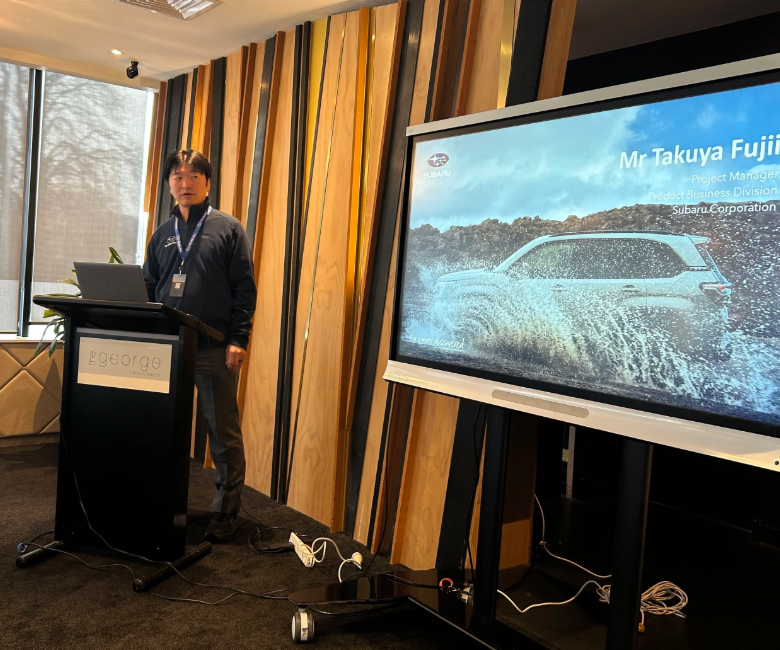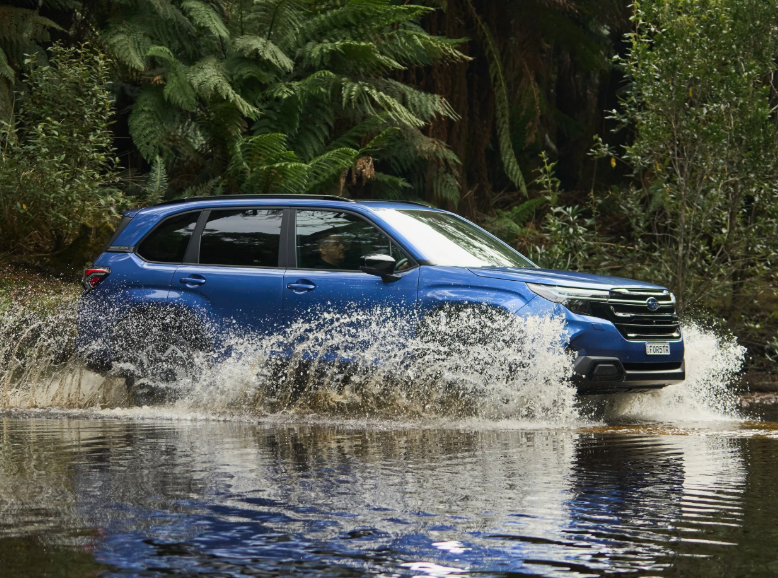LATEST NEWS
Forester development a tricky terrain
Richard Bosselman
July 30, 2025
Subaru’s nuggety wagon has to be Green, yet grunty, and achieve as an off-road champ yet also deliver solid on-seal mannerisms, development team Takuya Fujii explains.
IMPROVED fuel economy was a target for Subaru’s latest petrol-electric system, but benefits had to also favour performance - satisfying both was a balancing act.
So suggests the boss of the team that led development of the just-released sixth generation Forester sports utility wagon.
The first and, so far, only known recipient of the ‘super hybrid’ system co-developed with Toyota and involving a Toyota-sourced battery, traction motor and transmission is a key car for its maker.
While Subaru’s largest car, Outback, has historically been the best seller here, in every other place this make operates, Forester is generally the top dog for volume.
Takuya Fujii (above) says an imperative for his group was to protect the DNA of the Forester family, while at the same time ensuring the car continued to differentiate from segment rivals.
Speaking at the recent Australasian launch in Christchurch, Fujii said his role as project manager went well beyond ensuring the new electric-assisted powertrain that bases off, and offers as an alternate, to the petrol flat four that has been a core ingredient of this car would be up to scratch.
Hybrid is perhaps a sensitive subject for Subaru. The make doubtless felt extra pressure because this was a second go at delivering a technology imperative to reducing CO2 counts and containing fuel burn - both issues that blight the make’s trademark flat four engine.
The previous car’s hybrid system, developed in-house by his brand, failed to resonate well and questions were asked then about why Subaru didn’t ask for assistance from Toyota, which is not only a world-class expert but also holds 20 percent of Subaru’s stock.
Now it has, but the politicking that went on, the acceptances that were demanded and how Subaru - a fiercely independent maker - felt about having to seek help from Japan’s No.1 are perhaps still touchy subjects. If pride was pricked, then that’s all being kept under wraps.
For Fujii, super hybrid is all about eyes’ forward. But it is a big change and, aside from being able to marry this generation’s tech to it’s own engine, a lot that sits behind the carryover ‘e-boxer’ badge has Toyota’s prints on it.
Revision this time not only affects the powertrain proper, and the kind of battery now used, but the transmission. Somewhat brushed over in the presentations was that whereas the pure petrols keep Subaru’s stepped eight-speed Lineartronic CVT, the hybrid assumes Toyota’s hybrid trademark features of a planetary gearset and dual motor-generators. One motor drives the wheels and provides regenerative braking. The other manages engine starts and battery recharging.
Where the Forester differs from its Toyota equivalent, the RAV4, is in the way it keeps the wheels turning.
Symmetrical (aka full-time) all wheel drive is a feature Subaru has made its own thing; it was adamant there was no way the the market leader’s method - whereby front wheels are driven by an engine, rears by an electric motor, the two in complete isolation - would be accepted by customers who have long been satisfied by tried, trustworthy driveshaft-included preference that rotates all four wheels. Contention Subaru’s way is better for off-roading and all round traction was well proven on this event.
But what impact of fuel economy? As reported in our first drive report, Subaru’s raw data shows the Forester is nowhere near as meagre as a RAV4 hybrid. The marriage partner to Toyota’s tech is one reason; with 8.8 litres per 100km claimed using WLTP calculation, the 2.5-litre is actually slightly thirstier than before in isolation. The hybrid, with 6.9L/100km, seems only slightly thriftier than the previous system: Both by 0.5 litres per 100km. And the CO2 outputs from both engines are identical.
But the hybrid attests to a greater overall range; over 1000 kilometres, Subaru reckons, if you’re truly light-footed.
Up to 88kW of boost now is a vast improvement on 12.3kW assist from the old version. Forcing it into EV mode allows proper actual prolonged low-speed (sub 30kmh) battery-fed driving now; it also makes step-off smoother and, with 145kW of system output versus 136kW for the petrol, there’s benefit in mid-range oomph. It also enables handy additional assist when take on unformed terrain.
Fujii says that’s a reflection of what his team felt buyers wanted.
“Fuel efficiency is a major focus, but it is definitely not the only thing we focused on,” he said in a presentation.
“We needed to look back on our DNA and talk with our customers to find out what they really want from the hybrid Forester. (In doing so) we were able to achieve a very good balance of performance and economy.
“Acceleration has been improved. In fact, the hybrid is stronger and more responsive in terms of acceleration than the petrol model. The electric motor not only assists in providing a flat, even torque curve, but also better low-speed response, which is crucial in both on- and off-road driving.”
Subaru is looking to improving safety, ride/handling balance, and overall refinement of its products; Fujii says with Forester, there was dedication to delivering highly responsive handling and robust drivability across all conditions, the aim being to “empower every driver with precise and confident control.”
The process was more about evolution than a complete rethink. Fujii and his engineers knew the intrinsic ‘Forester formula’ could not be altered. The car has to maintain a certain feel and ambience. Still, he feels confident customers will immediately notice the major improvements to body rigidity and stability, handling, control, and the reduction of noise and vibration.
“Our new platform increases torsional rigidity by 10 percent when compared with the previous model. We adopted a full inner-frame construction method and increased the amount of structural adhesive by more than three times.”
One small engineering change set to make a major improvement is affixing the front seats directly to the frame, instead of the previous way which used a bracket between the seat and the body.
The effect of this is to enhance stability for the driver. “Coupled with overall stronger body construction, the design allows the driver to always feel safer and more connected to the vehicle.” There’s better comfort, too, from the front chairs having been improved to offer increased lower back support. Fujii said his engineers took a “scientific approach on designing the structure of the human body in order to fit (the seat) more firmly around drivers of all sizes and ages”.
A heap of time and resources went into making the car quieter, with more noise damping materials within the shell. Thicker front door glass aims to improve the clarity of conversations in the cabin. Insulative material in the toe board, firewall, dashboard, and transmission tunnel reduce sound.
Achieving aerodynamic improvement with a car that has generous (220mm) ground clearance and a boxy shape provided challenges, Fujii testifies, but he says the new car is more wind-cheating than any previously.
That’s benefitted economy and improved the car’s stability. Another ingredient for the latter, and driver feel, is adoption of a dual pinion electric assisted steering system where the drive motor is installed on the rack, and not on the column.
The off-road ruggedness is still paramount. Aside from having generous ground clearance, the approach, ramp-over, and departure angles are listed at 19.0 degrees, 19.3 degrees, and 24.7 degrees (SAE) respectively.
Subaru’s dual-mode X Mode all-wheel drive system has finessed to offer cross-axle torque vectoring by brake, and alternate traction modes for improved grip in mud, snow, and sand.
As much as it will be resultant on the wild, Fujii says Subaru knew Forester still had to have to on-road feel of any typical passenger car. Hence why his team was committed to tuning the coil springs, bushings, and dampers to reduce movements resulting in passenger head toss - an undesirable outcome of higher riding vehicles and common in many SUVs and utility vehicles - and oscillating upper body movements.




